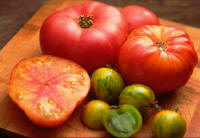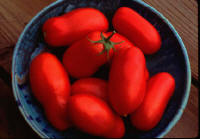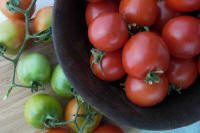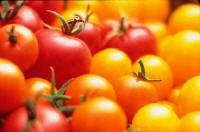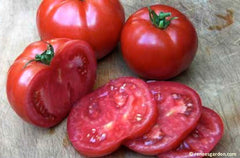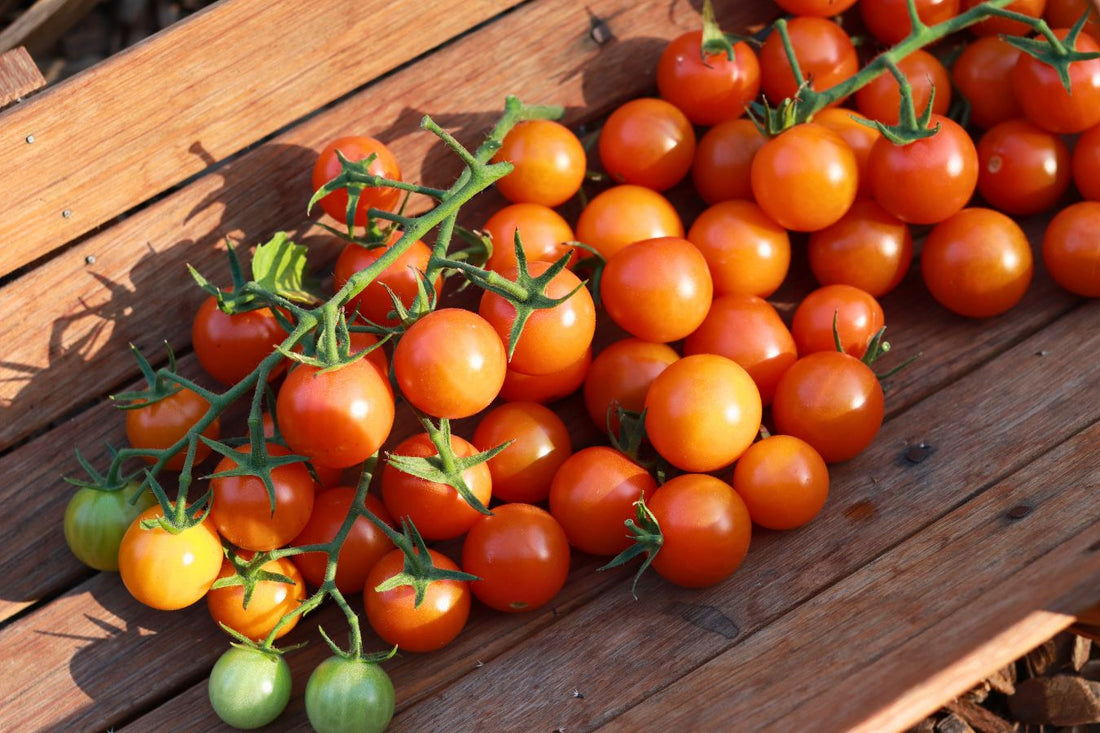
Generally, the time to start your seeds is about 6- 8 weeks before the last expected spring frost date in your area, planting the seedlings outdoors about 2 weeks after that date. Another way to figure is to plan on setting out sturdy seedlings in the garden when night temperatures stay in the mid-50 degree range both day and night. Count back and sow seeds 6 to 8 weeks before that date normally arrives. If you do not feel confident about timing, consult an experienced gardening friend, or ask at a good garden center or seek the advice of your local Master Gardener program.
 1. Starting indoors, in a container of well moistened, sterile seed-starting mix, make shallow furrows with a pencil or chopstick about 1/4 in. deep. Sow seeds by dropping them along the bottom of the furrows 1/2 in. apart.
1. Starting indoors, in a container of well moistened, sterile seed-starting mix, make shallow furrows with a pencil or chopstick about 1/4 in. deep. Sow seeds by dropping them along the bottom of the furrows 1/2 in. apart.
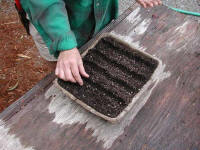 2. Gently pinch together soil to cover each furrow, covering seeds 1/4 in. deep. Water gently and label each variety. Put container in a warm place, 75-80˚ F. As soon as seed begin germinating and stems start to show above the soil, it's critical to provide a strong light source such as fluorescent bulbs or a very sunny window.
2. Gently pinch together soil to cover each furrow, covering seeds 1/4 in. deep. Water gently and label each variety. Put container in a warm place, 75-80˚ F. As soon as seed begin germinating and stems start to show above the soil, it's critical to provide a strong light source such as fluorescent bulbs or a very sunny window.
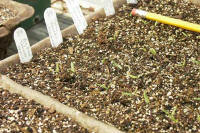 3. Day 7 - Seedlings have germinated. First to appear are "baby" or "cotyledon" leaves. Careful labeling of each variety is important as they all look alike.
3. Day 7 - Seedlings have germinated. First to appear are "baby" or "cotyledon" leaves. Careful labeling of each variety is important as they all look alike.
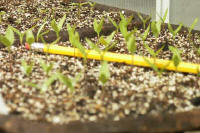 4. Day 15 - Seedlings are still tiny with just baby cotyledon leaves, but growing well. Note the nice green color of the baby leaves. This indicates that plants are getting enough bright light to thrive.
4. Day 15 - Seedlings are still tiny with just baby cotyledon leaves, but growing well. Note the nice green color of the baby leaves. This indicates that plants are getting enough bright light to thrive.
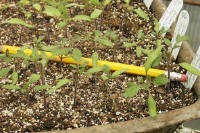 5. Day 30 - The first set of "true" tomato leaves begin to appear above the baby cotyledon leaves. The best example of this is in front of the pencil eraser in this picture.
5. Day 30 - The first set of "true" tomato leaves begin to appear above the baby cotyledon leaves. The best example of this is in front of the pencil eraser in this picture.
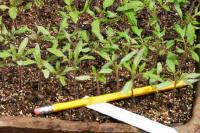 6. Now that true leaves have emerged on all the seedlings, it's time to transplant seedlings to larger individual containers so they have enough room to properly grow and develop. This process is called "pricking out" the seedlings.
6. Now that true leaves have emerged on all the seedlings, it's time to transplant seedlings to larger individual containers so they have enough room to properly grow and develop. This process is called "pricking out" the seedlings.
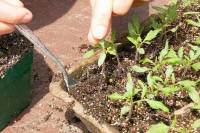 7. To "prick out:" lift seedlings from below, holding each one gently by their baby cotyledon leaves and scooping up entire soil ball from below. We find an old fork works well for this.
7. To "prick out:" lift seedlings from below, holding each one gently by their baby cotyledon leaves and scooping up entire soil ball from below. We find an old fork works well for this.
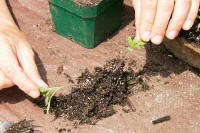 8. If roots have grown together into a clump, gently tease seedlings apart, holding by baby cotyledon leaves.
8. If roots have grown together into a clump, gently tease seedlings apart, holding by baby cotyledon leaves.
 9. Transplant each seedling into its own container (at least 3-4 in. in diameter) filled with good quality, well moistened potting mix. Make a hole to receive each seedling.
9. Transplant each seedling into its own container (at least 3-4 in. in diameter) filled with good quality, well moistened potting mix. Make a hole to receive each seedling.
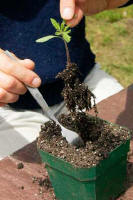 10. Insert each seedling into the hole to the base of its cotyledon leaves.
10. Insert each seedling into the hole to the base of its cotyledon leaves.
 11. Tomato seedlings will readily grow new roots along their buried stems and the resulting plants will be sturdy and vigorous. Gently water in the seedlings to settle the plants.
11. Tomato seedlings will readily grow new roots along their buried stems and the resulting plants will be sturdy and vigorous. Gently water in the seedlings to settle the plants.
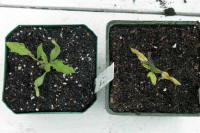 12. Here are examples of what healthy and cold stressed seedling look like. Remember that seedlings need to be kept at about 65 - 70 degrees after they have true leaves and until they are ready to go into the garden.
12. Here are examples of what healthy and cold stressed seedling look like. Remember that seedlings need to be kept at about 65 - 70 degrees after they have true leaves and until they are ready to go into the garden.
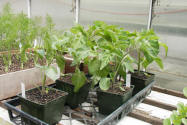 13. When spring weather has warmed up and night temperatures are regularly in the 55 degree range, it's time to plant well rooted, established seedlings outdoors. First plan to acclimate your plants: move them outside into the sun, first for a few hours , then gradually increasing over a weeks' time until they are in full sun all day. This process is called "hardening off" and it avoids transplant shock.
13. When spring weather has warmed up and night temperatures are regularly in the 55 degree range, it's time to plant well rooted, established seedlings outdoors. First plan to acclimate your plants: move them outside into the sun, first for a few hours , then gradually increasing over a weeks' time until they are in full sun all day. This process is called "hardening off" and it avoids transplant shock.
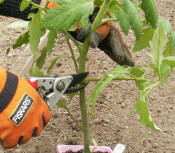 14. At transplanting time, if hardened off young plants are more than 6 in. tall, remove the bottom branches before planting. New roots will form along the buried stem.
14. At transplanting time, if hardened off young plants are more than 6 in. tall, remove the bottom branches before planting. New roots will form along the buried stem.

 16. Tip out plant by overturning pot to squeeze or tap out the entire root ball. Note the snipped off lower branches on this example ready to go into the ground.
16. Tip out plant by overturning pot to squeeze or tap out the entire root ball. Note the snipped off lower branches on this example ready to go into the ground.
 17. Settle the seedling into the hole, so the entire stem will be covered up to where leafy branches begin. Pull soil around the plant and firm.
17. Settle the seedling into the hole, so the entire stem will be covered up to where leafy branches begin. Pull soil around the plant and firm.
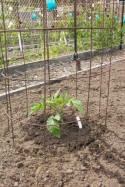 18. Water gently but thoroughly and erect your tomato supports. Be sure they are well secured, because your plants will grow large and heavy with fruit, so you will need strong support for the branches.
18. Water gently but thoroughly and erect your tomato supports. Be sure they are well secured, because your plants will grow large and heavy with fruit, so you will need strong support for the branches.
24. Big Beef beefsteak giant slicers are heavy with sweet flesh and lots of juice - perfect for open-faced "BLT" sandwiches.
 1. Starting indoors, in a container of well moistened, sterile seed-starting mix, make shallow furrows with a pencil or chopstick about 1/4 in. deep. Sow seeds by dropping them along the bottom of the furrows 1/2 in. apart.
1. Starting indoors, in a container of well moistened, sterile seed-starting mix, make shallow furrows with a pencil or chopstick about 1/4 in. deep. Sow seeds by dropping them along the bottom of the furrows 1/2 in. apart. 2. Gently pinch together soil to cover each furrow, covering seeds 1/4 in. deep. Water gently and label each variety. Put container in a warm place, 75-80˚ F. As soon as seed begin germinating and stems start to show above the soil, it's critical to provide a strong light source such as fluorescent bulbs or a very sunny window.
2. Gently pinch together soil to cover each furrow, covering seeds 1/4 in. deep. Water gently and label each variety. Put container in a warm place, 75-80˚ F. As soon as seed begin germinating and stems start to show above the soil, it's critical to provide a strong light source such as fluorescent bulbs or a very sunny window. 3. Day 7 - Seedlings have germinated. First to appear are "baby" or "cotyledon" leaves. Careful labeling of each variety is important as they all look alike.
3. Day 7 - Seedlings have germinated. First to appear are "baby" or "cotyledon" leaves. Careful labeling of each variety is important as they all look alike. 4. Day 15 - Seedlings are still tiny with just baby cotyledon leaves, but growing well. Note the nice green color of the baby leaves. This indicates that plants are getting enough bright light to thrive.
4. Day 15 - Seedlings are still tiny with just baby cotyledon leaves, but growing well. Note the nice green color of the baby leaves. This indicates that plants are getting enough bright light to thrive. 5. Day 30 - The first set of "true" tomato leaves begin to appear above the baby cotyledon leaves. The best example of this is in front of the pencil eraser in this picture.
5. Day 30 - The first set of "true" tomato leaves begin to appear above the baby cotyledon leaves. The best example of this is in front of the pencil eraser in this picture. 6. Now that true leaves have emerged on all the seedlings, it's time to transplant seedlings to larger individual containers so they have enough room to properly grow and develop. This process is called "pricking out" the seedlings.
6. Now that true leaves have emerged on all the seedlings, it's time to transplant seedlings to larger individual containers so they have enough room to properly grow and develop. This process is called "pricking out" the seedlings. 7. To "prick out:" lift seedlings from below, holding each one gently by their baby cotyledon leaves and scooping up entire soil ball from below. We find an old fork works well for this.
7. To "prick out:" lift seedlings from below, holding each one gently by their baby cotyledon leaves and scooping up entire soil ball from below. We find an old fork works well for this. 8. If roots have grown together into a clump, gently tease seedlings apart, holding by baby cotyledon leaves.
8. If roots have grown together into a clump, gently tease seedlings apart, holding by baby cotyledon leaves. 9. Transplant each seedling into its own container (at least 3-4 in. in diameter) filled with good quality, well moistened potting mix. Make a hole to receive each seedling.
9. Transplant each seedling into its own container (at least 3-4 in. in diameter) filled with good quality, well moistened potting mix. Make a hole to receive each seedling. 10. Insert each seedling into the hole to the base of its cotyledon leaves.
10. Insert each seedling into the hole to the base of its cotyledon leaves. 11. Tomato seedlings will readily grow new roots along their buried stems and the resulting plants will be sturdy and vigorous. Gently water in the seedlings to settle the plants.
11. Tomato seedlings will readily grow new roots along their buried stems and the resulting plants will be sturdy and vigorous. Gently water in the seedlings to settle the plants. 12. Here are examples of what healthy and cold stressed seedling look like. Remember that seedlings need to be kept at about 65 - 70 degrees after they have true leaves and until they are ready to go into the garden.
12. Here are examples of what healthy and cold stressed seedling look like. Remember that seedlings need to be kept at about 65 - 70 degrees after they have true leaves and until they are ready to go into the garden. 13. When spring weather has warmed up and night temperatures are regularly in the 55 degree range, it's time to plant well rooted, established seedlings outdoors. First plan to acclimate your plants: move them outside into the sun, first for a few hours , then gradually increasing over a weeks' time until they are in full sun all day. This process is called "hardening off" and it avoids transplant shock.
13. When spring weather has warmed up and night temperatures are regularly in the 55 degree range, it's time to plant well rooted, established seedlings outdoors. First plan to acclimate your plants: move them outside into the sun, first for a few hours , then gradually increasing over a weeks' time until they are in full sun all day. This process is called "hardening off" and it avoids transplant shock. 14. At transplanting time, if hardened off young plants are more than 6 in. tall, remove the bottom branches before planting. New roots will form along the buried stem.
14. At transplanting time, if hardened off young plants are more than 6 in. tall, remove the bottom branches before planting. New roots will form along the buried stem.
15. Prepare the hole to receive the seedling.
 16. Tip out plant by overturning pot to squeeze or tap out the entire root ball. Note the snipped off lower branches on this example ready to go into the ground.
16. Tip out plant by overturning pot to squeeze or tap out the entire root ball. Note the snipped off lower branches on this example ready to go into the ground. 17. Settle the seedling into the hole, so the entire stem will be covered up to where leafy branches begin. Pull soil around the plant and firm.
17. Settle the seedling into the hole, so the entire stem will be covered up to where leafy branches begin. Pull soil around the plant and firm. 18. Water gently but thoroughly and erect your tomato supports. Be sure they are well secured, because your plants will grow large and heavy with fruit, so you will need strong support for the branches.
18. Water gently but thoroughly and erect your tomato supports. Be sure they are well secured, because your plants will grow large and heavy with fruit, so you will need strong support for the branches.19. Enjoy the harvest! For heirloom varieties like our Rainbow's End, it's best to wait for full ripeness before picking the luscious, color fruit.
20. Slicers, like Crimson Carmello or Chianti Rose can be harvested at any stage you like them.
21. Don't forget your sauce tomatoes. Here's a bowl of our variety Pompeii all ready to put up. We like to freeze them whole, then make sauce later when the weather is cold and miserable, and making big pots of tomato sauce is fragrant fun.
22. Heirloom Camp Joy cherry tomatoes are very prolific and delicious.
23. Garden Candy Cherries are beautiful in the garden and kitchen.
24. Big Beef beefsteak giant slicers are heavy with sweet flesh and lots of juice - perfect for open-faced "BLT" sandwiches.

